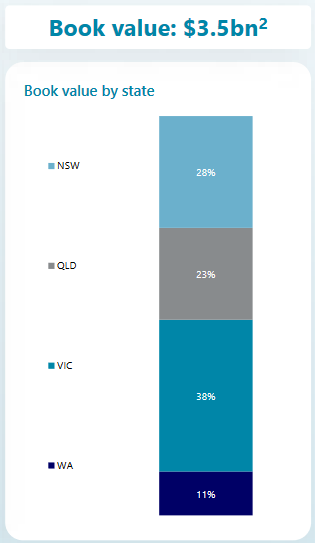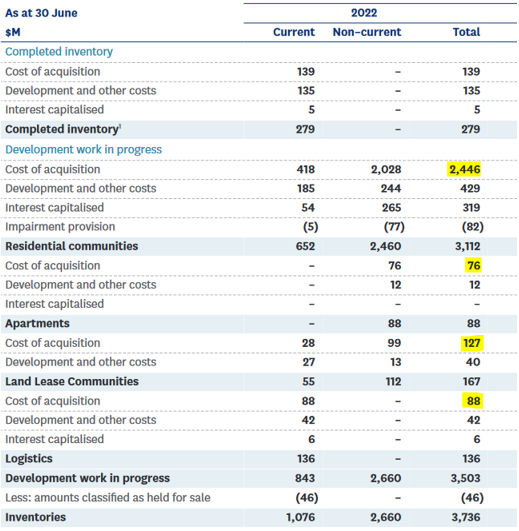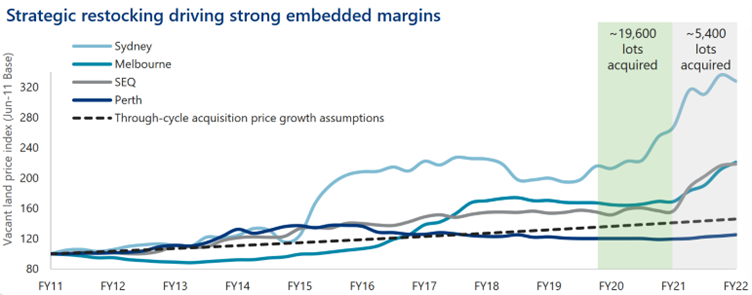Hidden property value within a property stock
"The best place to hide something is in plain sight" Edgar Allan Poe
We have spent countless hours these past few years hunting for asymmetric opportunities. We have uncovered these in many forms but 2 common sources have been:
- Companies trading below book value (ORG, NUF, ASB, SM1) and
- Companies with underappreciated/hidden property value (Ramsay, Casinos, Aged Care, Energy, Agribusiness, etc)

In a recent review of Real Estate Investment Trusts (REITs) we were struck with the thought that the most obvious example of underappreciated property value might actually be hiding within a property stock, trading at less than book value. We detail this company below. I preface this work with a disclaimer that along with my love of food, movies and mining, I love property but am a generalist on the topic and hence have (potentially crudely) attempted to generalise this note.
Background to Stockland
As we know it today Stockland (SGP) is a stapled security and represents a combination of passive income streams within a trust: Retail ‘Town Centres’, Office ‘Workplaces’, Industrial ‘Logistics’ and Retirement / Land lease communities; and development income streams within a corporation: Residential is mainly master planned communities (MPC), Commercial Developments and Land lease communities. Stockland is regarded as one of Australia’s most recognised brands and develops on average 6,000 lots p.a. sold within MPCs.
In June 2021 SGP announced the appointment of a new CEO, Tarun Gupta whose appointment has coincided with a refinement in the company’s strategy. This refinement in strategy includes a reallocation in sector capital and a refocus on targeted returns. This has seen SGP divest its Retirement Living business and acquire Halcyon a land lease communities business, as well as enter into multiple (capital) partnerships to accelerate SGP’s development pipeline. A summary of these targeted measures is presented in the images below.
We are cognisant of the rising interest rate environment and implications it may have on Australia’s property market and hence SGP’s earnings (predominantly the development earnings) but the argument presented herein is both an absolute and relative valuation argument vs REIT 'peers'.
Underappreciated Land Value
For those that have never looked at REITs, simplistically the majority of a REIT’s value[1] is marked to market at each reporting date via external valuations predicated on the capitalisation of recurring income streams, i.e., cap rates, which adjust according to market conditions including changes in yields. This is true of SGP’s trust assets. The component of most REITs that isn’t as simple is the development portfolio[2] which is often recorded at cost. As noted above SGP is a combination of a trust and a corporation[3] and is somewhat unique in the weight of the business towards development. Lend Lease (LLC) and Mirvac (MGR) are possibly the only 2 other ASX property stocks that are development heavy.
With the uniqueness of SGP’s development pipeline vs REIT ‘peers’ it is understandable that its upside value is potentially being overlooked. If we consider the net tangible asset (NTA) or book value of SGP, notably the landbank is recorded at cost and being approximately 10 years old the land recognized on SGP’s balance sheet grossly understates its market value. This clearly begs the question how much the land is actually worth which we have attempted to answer below.

Source: SGP FY2022 Results Presentation Annexure
On our first attempt at estimating land value, we considered what is being reported by SGP, being a AUD3.5bn cost base for the ~10 years old landbank (refer image above). From review of prior announcements and company discussions however we have discovered that the AUD3.5bn of book value at cost included development and other costs, interest capitalised, etc. Hence we needed to refine the true cost of land we were considering, refer below.

Source: SGP FY2022 Account Statements, note 6 Inventories page 126
I.e., Of the AUD3.5bn of book value, AUD2,737m of that is ‘cost of acquisition’. Per the accounts that includes legal, valuation and stamp duty costs which we have assumed at ~7.5%, hence our estimated raw acquisition cost (AUD2,546m below) is adjusted for these estimated costs.
Furthermore, the average age of SGP’s landbank, although stated at 10 years, is being inflated by project Aura on the Sunshine Coast, which was effectively purchased as part of SGP’s acquisition of Foster’s Lensworth Group in 2004 (for AUD846m)[4]. Ex Aura the average age of the landbank is actually closer to 8 years.
The image below which shows select land value movements across Australia since FY2011 highlights the material uplift in land seen over the past 10 years which we have utilised in our analysis.

Source: Stockland FY2022 Results Presentation, page 29
Below we have tabled our estimate of what this might mean for the current value of SGP’s landbank, relying on the average move per city (representative of the respective state), presuming[5] that the landbank was acquired on average 8 years ago. We further note that it is important to realise that SGP make acquisitions with a through-cycle acquisition price assumption (3.5% p.a.) embedded into the acquisition to justify the price paid for the land, hence we need to adjust for this. In addition there are also liabilities (of ~AUD1.4bn) that offset this gross value of land on SGP's balance sheet that reflect cost to complete provisions and deferred payments, some of which are revenue based and adjust with land price movements. I.e. there are definitely some complexities in calculating what the land is really worth!
Source: Chester Asset Management with sources referred to in Notes above
* On Aura, it was reported Terry Snow’s Capital Property Group (CPG) invested ~AUD175m (AUD150-200m) for 50% of the project at a reported 30% premium[6]. Hence we presume book value for the remaining 50% is recorded at ~AUD135m (AUD175m/1.4). From a similar exercise to that above we estimate this land is now worth ~AUD270m vs AUD205m implied by the ~50% (75%x70%) factored above so we add an extra AUD65m.
NTA
The first point to make about SGP trading at a discount to book value is that this is the case for almost all REITs. Hence for comparison below we present our REITs database, removing fund managers (CHC, CNI, GMG and HMC) and included SGP at the adjusted NTA calculated above. Furthermore, this table excludes retirement living operators/developers (LIC and INA) and property developer LLC.
The comparison table above highlights that when adjusting SGP NTA for a more appropriate view of land value we observe a 32% discount to NTA vs the REIT average of 22%. I.e., If our estimate of SGP’s land value is correct SGP has ~15% upside just to trade at the average of the REIT’s index (AUD4.00/share). Or put another way SGP is currently trading at <0.7x our estimate of adjusted NTA.
Property Developer Premium
Above we noted that SGP on an adjusted basis trades at a material discount to the average of REIT peers[7]. Arguably, as has historically been the case, developers should trade at a greater premium[8] to NTA than pure REITs. This is because the NTA doesn’t capture the value of future development earnings (outside of the land value being realised). Hence why LIC has traded at >3x NTA, INA 1.5x and LLC has traditionally traded at an ~30-50% premium. SGP itself currently trades at an ~20% discount to its reported NTA vs a long term average premium of 10-15%.
We could have left it there and said SGP has >35% to trade back to its historic premium to NTA but why make it easy? Instead we have performed an additional exercise to the land adjustment above to consider ‘development value’. The challenge in doing so though is in defining what is the development profit, particularly when we believe land value is being grossly understated. If we were to count development profits on top of adjusted NTA we would effectively be counting the land uplift twice. In the table below we have attempted to isolate the profit attributable to the land mark-to-market and the residual development profit and quantify this value. For simplicity (and somewhat materiality) we have only included development upside for standard residential lots (i.e., excluded any development upside for land lease and commercial portfolios).
Source: Chester Asset Management with sources referred to in Notes above
This compares to the NAV/share reported in IRESS for each of these companies below.
Source: Chester Asset Management, with data from IRESS and company accounts, as at 15 September 2022
Notably Rural Funds Group (RFF) present in their accounts adjusted NAV per unit which adjusts the book value of water entitlements to an independent valuation rather than at cost. Unlike SGP RFF trades reasonably in line with this adjusted NAV. The discount of REITs is ~21% to their NAV. Assuming this average discount applied to SGP the comparable price would be ~AUD4.90/share, +40% to where SGP is trading. I.e., SGP is trading at ~0.55x this adjusted NAV.
Cap Rates above peers
We appreciate comparing the cap rate of one property play to another doesn’t necessarily account for differences in asset quality but per Chester analysis in aggregate SGP have cap rates above the average of the REIT peer group: Retail 0.78% higher than peers, Office in line. and Industrial ~0.23% lower than peers. Assuming this is just conservatism and not due to lower quality assets than peers SGP’s investment properties should trade at a lower discount than peers (i.e., <21% discount).
Source: Chester Asset Management, with data from company accounts
Gearing more conservative than peers
With the sale of Retirement, divestments and capital partnering deals SGP’s pro-forma gearing is actually 500bpts better than last reported at ~18%. Given this is below SGP’s targeted gearing of 20-30% the company may re-gear but SGP is also looking to scale further via the use of 3rd party capital to obtain better operating leverage and generate recurring fee income. For comparative purposes below we have tabled how SGP’s balance sheet compares to peers.
As is evident in the table above vs peers SGP has: a lower level of gearing; a higher level of hedging; longer dated maturity; and also, a higher starting debt cost, which we see as a positive as there is less of a future headwind from debt repricing.
Higher Yield
It is worth pointing out the difference in dividend yield vs peers. We had heard the bear argument that with the sale of the Retirement business SGP is entering a tax paying position that the market wasn’t on top of. This came through at the FY22 results with FY23 FFO guidance inclusive of tax payable at 5-10%. With Development targeted to represent ~40% of profits this would mean as a stapled security the normalised forward tax rate would increase from ~7.5% to ~12% (30% x 40%) which should now be in consensus. We further note the dividend could be franked to ~33% so the gross dividend would be higher than this vs REITs (Trusts) that pay unfranked distributions.
Source: Chester Asset Management, with data from IRESS as at 15 September 2022
Developers should be paying a lower dividend so it doesn’t really make sense that the SGP dividend, despite now incorporating tax payments (and hence potentially franking) is still materially above that of pure REITs (except if the buyside are anticipating material downgrades to consensus).
Closing
You could argue that development profits will dry up in the near term and the market may need to adjust FY23 to FY25 earnings expectations for the recession/property market downturn but we still see a pretty asymmetric opportunity for SGP on a valuation basis. We have tried to represent this in the graph below that if we were to adjust land on SGP’s balance sheet for its hidden value we see upside to at least AUD4.00/share at the absolute minimum (to reflect the average REIT discount) and upside beyond that dependant on how much additional value to include for SGP’s development pipeline(s).
[1] And we are ignoring Funds Management REITS here
[2] Which is generally a nominal component of asset value
3 topics
18 stocks mentioned

